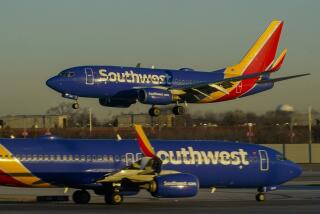US, Australia Reach Open Skies Agreement
Australia and the United States have reached a bilateral “open skies” aviation agreement, the countries announced Friday, clearing the way for increased competition on one of the world’s most lucrative and protected long-haul routes.
The bilateral agreement abolishes all restrictions on U.S. and Australian air services for carriers of both countries, ending a virtual duopoly on the route held by Qantas and UAL Corp.’s United Airlines. Qantas controls 75 percent of the market share on the Australia-U.S. route, from which it derives around 15 percent of its net profit.
The deal will allow Australian carrier Virgin Blue Holdings Ltd. to begin flights to the United States by the end of the year -- but leaves Singapore Airlines Ltd., which has long coveted the route, still without access.
It would also “provide certainty” for Australia’s Qantas Airways Ltd. and its budget offshoot Jetstar, allowing them to widen the network of American cities they currently serve, Australian Transport Minister Anthony Albanese said in a statement.
The agreement comes after three days of negotiations in Washington and will take effect once formal approval from the U.S. and Australian governments is granted.
“Airlines from both countries will be allowed to select routes and destinations based on consumer demand, without limitations on the number of U.S. or Australian carriers that can fly between the two countries or the number of flights they can operate,” a U.S. Department of Transport statement said.
“The agreement also removes restrictions on capacity and pricing, and provides opportunities for cooperative marketing arrangements, including code-sharing, between U.S. and Australian carriers,” it said.
The agreement only applies to American and Australian carriers.
The Australian government last year denied Singapore Airlines’ request to start services in the corridor on the grounds that opening up the route to the Asian carrier would bring only minor tourism benefits and could hurt the economy. The carrier had hoped a change in government in Australia last November would see a softening of opposition to its ambitions.
Singapore Airlines said that hope had been squelched by Friday’s agreement.
“The agreement to liberalise for Australian and American carriers on the U.S. route is long overdue,” Stephen Forshaw, Singapore Airlines’s vice president for public affairs said in a statement. “But it is only half a step.”
The company repeated its accusation that the Australian government was unfairly protecting Qantas from competition by denying Singapore Airlines access to the trans-Pacific route.
Qantas Chief Executive Geoff Dixon welcomed the agrement and said the airline would increase its flights on the route to 51 a week from March from 48 a week now.
He urged the government to persue similar agreements with other countries.
“Further liberalization of air services arrangements with a number of counries if needed if Australian carriers are to grow operations and match opportunities availble to foreign competitors,” Dixon said in a statement.
Virgin Blue, Australia’s second-largest airline by revenue, wants to fly 10 Boeing 777-300ER services a week to the U.S. West Coast through its new international carrier, V Australia.
The airline last year got approval from the Australian government to add trans-Pacific routes, but an agreement with the U.S. was still needed.
“The new agreement will provide great opportunities for increasing trade and commercial links between Australia and the U.S.,” Albanese said.
Shares in Qantas fell as investors mulled the increased competition threat but recovered some ground to finish 2.53 percent lower at 4.63 Australian dollars. Virgin Blue rose 2.76 percent to A$1.49.
More to Read
Sign up for The Wild
We’ll help you find the best places to hike, bike and run, as well as the perfect silent spots for meditation and yoga.
You may occasionally receive promotional content from the Los Angeles Times.






